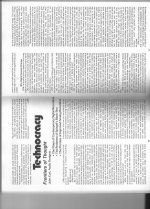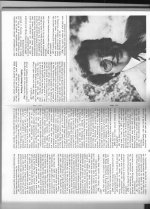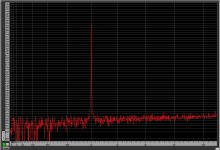I would guess that for continuous tones, both in amplitude and frequency, dithering does a great job of hiding any instantaneous departure from ideal. What about real music and speech that is ALWAYS CHANGING both in amplitude and frequency content?
So I take it that you didn't bother to listen to Werner Ogiers's demonstrations?
Do you mean to tell me SY, that IF I went along with you about double blind tests, then my mild annoyance with digital would disappear? I mean, not with just during the test, but forever?
Hard to say- there are people who get so set in their opinions that no amount of data will sway them. But if you're willing to actually do an ears-only listening test, I will be delighted to set it up and run it for you when I'm next in the Bay Area.
Don't worry SY, I did ABX tests 35 years ago, and I know that I cannot hear any difference between just about anything. I guess I should have given up audio then, but I still had a certain amount of trust in my own ears. It has worked out for me, and I will continue to rely on others to tell me the effective quality of what I design, for the most part. I am too old to be bothered with double blind tests.
Sy,
What would your ears only test compare. If you could cue up an album and a CD so they were tracking each other, I know highly unlikely if not impossible, wouldn't you always be able to tell which was the vinyl no matter if it was brand new vinyl and even direct to disk? Isn't that just a preference test in most cases, even if we both know the CD is the more accurate media?
I imagine that isn't what you propose but how would you ever overcome John's preference for vinyl sound?
What would your ears only test compare. If you could cue up an album and a CD so they were tracking each other, I know highly unlikely if not impossible, wouldn't you always be able to tell which was the vinyl no matter if it was brand new vinyl and even direct to disk? Isn't that just a preference test in most cases, even if we both know the CD is the more accurate media?
I imagine that isn't what you propose but how would you ever overcome John's preference for vinyl sound?
John you and Richard can really make engineers cringe - dither decorrelates quantization error - don't you understand the meaning of decorrelate? after all you do brag of grad level EE course when it suits you to claim EE expertise that you never actually display in these discussions
I think we both understand that about dither. To me, it just alters the dynamic range. As well as, making the annoying distortion into additional noise. Not the best solution.... just not so annoying. More bits is better. .... with or without dither.
THx-RNMarsh
Last edited:
Sy,
What would your ears only test compare.
Analog chain vs analog chain with ADC/DAC inserted.
Here is what I thought about digital, when I was 1/2 my present age. It hasn't changed much since then:
I guess I have trouble imagining not being curious or open minded enough to learn about new technologies that I don't understand.
I would guess that for continuous tones, both in amplitude and frequency, dithering does a great job of hiding any instantaneous departure from ideal.
What about real music and speech that is ALWAYS CHANGING both in amplitude and frequency content?
There's a good Wiki overview, with some video related examples.
Dither - Wikipedia, the free encyclopedia
Yes, I have made an attempt to understand digital theory and practice, but in evaluating the OPPO 105 in the last year or so, and owning it, I just don't find it as good as the best analog. Demian once made a really good CD player that we used to use at CES. It was pretty darn good, but vinyl was better.
... or 1uVpp ?
Thank you BV and my apologies to all for the mistake.
The 2nd line from the end should be:
"So this 30nV is the 1/3 of what the 0.1% of the 1mVpp (which is 1uVpp) that Richard is talking about."
And on all this numbers play, I haven’t included the beneficial effect of dithering.
Thank you George.
I think I can imagine how this also works depending on whether that sin wave is at 20hz or at 20Khz.
You are welcome Steven
The slicing is done on the height (amplitude) of each sample.
Bit Rate has to do strictly with the amplitude, not with the frequency.
If you see each sample in isolation, it does not contain any information regarding the frequency of the analog signal. Only if you place each consecutive sample side by side the meaning of frequency shows up.
Preservation of the analog signal’s frequency is under the responsibility of sampling frequency (how many samples per second, e.g. 96kHz=96000 samples per second).
And this sampling frequency has to be at least two times the highest frequency found in the analog signal (that’s why LP filtering ahead of the ADC is crucial)
So back to my other question. Now if you used a CDP…
CDs are 16bit encoded. It is not advisable for (sensitive ears) to use the digital attenuator of the CDP as a volume control for to achieve a lot of attenuation.
But if you have a digital platform which works on 32 or 64 bits, the issue turns IMO academic. (*)
Witch-hunters can use a switch for implementing a generous analog attenuation of say –40 dB downstream of the DAC and use the DAC's digital attenuator for the other 20-30dB.
Good Morning all!
Yes. this is what I was getting at.
Now throw in some numbers from jitter, analog noise and harmonics and various other artifacts and we have a hard time In Practice reaching and keeping below those numbers in a system of components.
Yes but except jitter all else is in the analog part of the system (as jcx writes: “the limit is the room, mic, preamp's, other analog noise floors”)
So, this brings me back to the conclusion that more bits to throw away for the cause to get the range of low distortion required to be truely transparent in practice. Which is starting to happen for other reasons as well (clipping headroom, etc)
I find clipping and headroom the most important -and most frequently abused- quality factor but gain structure is not related to the bit rate used or selected.
When you get rid of all the processing to make and playback a spinning LP or CD (16bits) AND it is 24/96+ the improvement is - I dare to say - dramatic.
And because life is short, if one has a lot of music material in cassettes, LPs or CDs, he’d better enjoy listening to them as is and the heck with the promised dramatic improvement in playback ‘quality’ with 24/96 downloads of the same music
George
(*) With my 2x4 miniDSP I use the digital volume as the system’s volume control. The DSP core works with 'only' 28bits (but I am clinically deaf so, don’t count my opinion).
Last edited:
Thanks again George. I see what you are saying about the frequency, I see the difference between the vertical stacking for the amplitude vs where frequency is coming into play now. You should have been a teacher, you would have made electronics and physics so much more interesting!
Dvv, I think that your questions are difficult to answer properly.
First, there have been many articles on minimum distortion, BUT THD is one of the worst predictors without weighing the harmonics STRONGLY. Putting any kind of number down, without qualifying the harmonics is almost pointless.
Speaker sensitivity is interesting in that there are limits on physical drivers that keep the dynamic range to something 'managable' no matter what the sensitivity. On one hand you have the problem with clean power and heat problems with inefficient speakers (85dB), and cost, excursion limitations, and even Doppler distortion with efficient speakers with limited cone area.
Besides, what is important is what we can hear with quality audio playback equipment, rather than any single number that we could state. Yet, I do know what you are talking about, so keep on truckin' !
John, I am fully aware of the associated problems to give a truly meaningful number. Ultimately, I have experienced them myself, even as an amateur. Let's just say I have a fairly good idea of what's in front of you when you have to give a spec to the ad department.
And I couldn't agree more that what goes on with the harmonics and their decay rate is of paramount importance. In fact, I have trained to be able to fairly reasonably predict the sound of a power amp based on its harmonic decay - far from perfect, of course, but a fair idea.
However, it surprises me that the the measurement guys here play deaf and dumb to my original question, and I didn't ask for a three word solution. As things stand, a few people here mentioned a safe minimum of -120 dB, which is 0.001%, a number I find to be ridiculously low as a true requireent for non-audibility. If you can have it, sure, why not, but I find it hardto believe that any human can safely (say 8/10) actually hear a PEAK THD distortion smaller than 0.1% - if that. I could be wrong, to be sure, but if so, let's try to agree on a REASONABLE number which should do it.
I am not asking this just for fun. Look at what's on offer on the world market, and skip mass produced products. For example, Metaxas amps are advertised as having 0.05% or less, 20-20.000 Hz, any load down to 4 Ohms. And they are anything but cheap. My own Marantz 170 DC power amp has the same spec and it doesn't stop it from sounding really great. Ny H/K PA2400 is even worse than that in terms of specs, but it sounds really good as well, lots of power (nominally 170W/8 Ohms, twice that into 4 Ohms and 650 Watts into 2 Ohms). Both have nice, "regular" harmonic decay rates. Obviously, low THD specs mean next to nothing in practical terms, in real life it could go either way.
Speaker efficiency is also no laughing matter. It's hardly all the same if your speaker does say 86 dB/2.83V/1m or 95 dB SPL/2.83V/1m like JBL's 4312. A 9 dB difference in efficiency translates to something like (off hand) 8 times more or less power for the same effect. With a high efficiency speaker, pure class A operation become very viable, you probably won't need more than 50Wrms for thunder in your room. My speakers are rated at 92 dB, old AR94s for 88 dB, and even I can hear and see by looking at the volume pot position that this is not a small difference.
It's fine to discuss these points no matter what anyone thinks, but for that to have any meaning, we need to decide where are the lines of acceptable THD figures and efficiency levels for speakers so we know what we are talking about. So when X says "low THD", it's not just anything, but a figure at or below a certain agreed upon limit.
Otherwise we'll be forever running loops around even basic concepts. Just look at the discussion over Richard's idea of downloading uncompressed high quality signal - the idea is so logical and clear, as I understood it, what Richard is saying reduce the possibility of spoiling musical moments by unnecessary in-between steps like cutting to CD, and then decoding it God knows how because he has to read the disc first. What the hell is the discussion about? Does somebody WANT a more complicated process which by itself introduces new variables?
Presonally, I think Richard's idea is a good one, and I daresay an obvious one, so I for one would be willing to pay for such high quality source material.
I was a technical instructor (among other things)
George
It shows, thank God.
I politely decline your invitation.
I guess I have trouble imagining not being curious or open minded enough to learn about new technologies that I don't understand.
Someone won't look through the telescope.
I suppose this is urinating into the wind, but if you actually do want to learn enough about digital methods so that you don't sound foolish when you talk about them, MIT has a great online course.
https://www.edx.org/course/discrete..._12_2015)&mc_cid=d9e409820d&mc_eid=86f7fa5b7b
Richard, what PMA is showing is the SIGNAL AVERAGED distortion after dithering, I'm pretty sure. I think that is where the essential problem lies. Dithering, WHEN averaged, hides the essential nonlinearity that has to be there by the finite number of bits used at low levels. It hides it pretty well, in fact, BUT the instantaneous nonlinearity is still there. OK, SY prove me wrong, I would like to believe that 'digital is perfect' in principle.
What PMA showed was, in my opinion, a computer generated -60dB file that was loaded directly into analyzer.
I can do that too, see below.
997Hz, -60dB FS, 24 Bit, NO DITHER, PEAK reading, Hanning window, 32k FFT (0.7Hz resolution).
You see - there are no traces of distortion. Why the 'floor' looks like a noise is a puzzle to me..
BUT (!!!) good luck getting the low distortion numbers, like in PMA's post, in real life during signal capture. Take a look at any modern ADC datasheet - 'best' ones show theoretical THD+N numbers around -56 to -60 dB relative to the -60dB FS signal. And that's more like 0.1-0.15% , not 0.02% !
Attachments
Why the 'floor' looks like a noise is a puzzle to me.
No puzzle at all. Your starting "opinion" is likely incorrect. This looks like a loopback.
BUT (!!!) good luck getting the low distortion numbers, like in PMA's post, in real life during signal capture. Take a look at any modern ADC datasheet - 'best' ones show theoretical THD+N numbers around -56 to -60 dB relative to the -60dB FS signal. And that's more like 0.1-0.15% , not 0.02% !
Thermal noise of a good cartridge might be -70dB, so even if your numbers are correct, that's hugely worse, even for a perfect record/TT (which don't exist). But I don't think your numbers are correct.
http://www.ti.com/lit/ds/symlink/pcm4220.pdf
- Status
- Not open for further replies.
- Home
- Member Areas
- The Lounge
- John Curl's Blowtorch preamplifier part II


